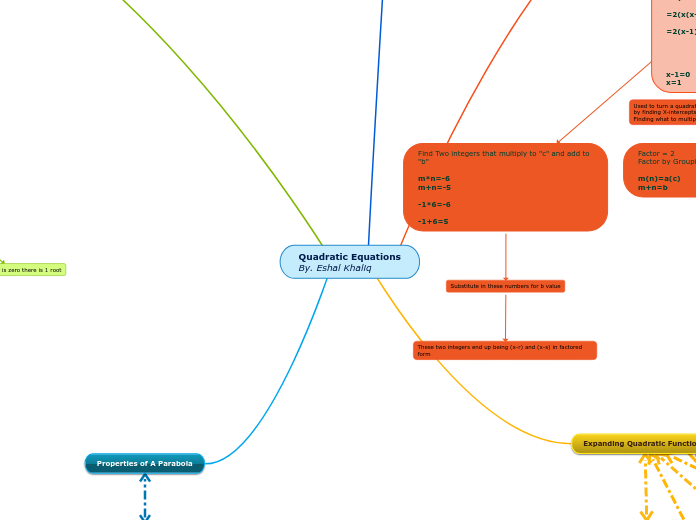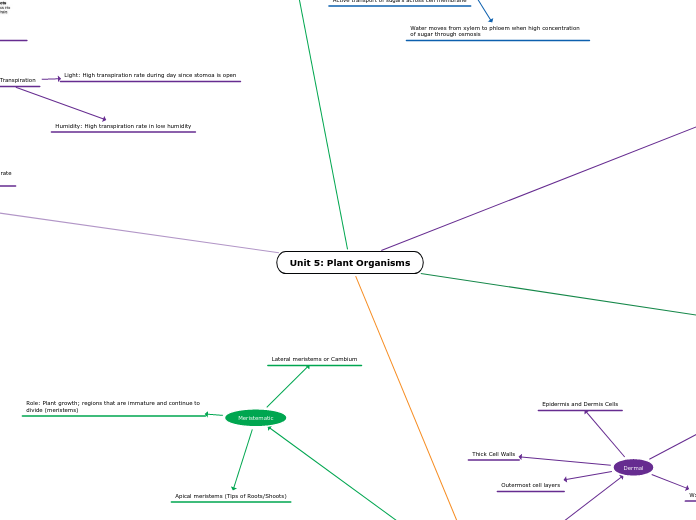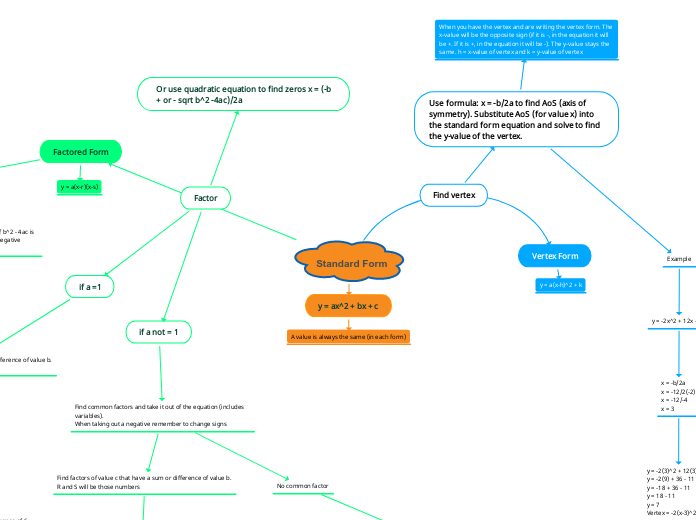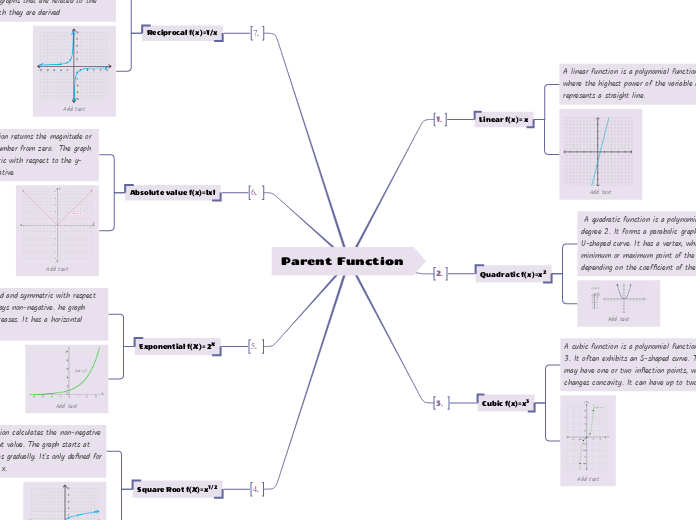Trinomial Standard Form
ax^2+bx+c
----------------------------
2x^2+10x-12
=2(x^2+5x-6)
=2(x^2-1x+6x-6)
=2(x(x-1)+ 6(x-1)
=2(x-1)(x+6)
x-1=0 x+6=0
x=1 x=-6
If the trinominal cannot be common factored and the a value is more than 1, you have to multiply a and c
Factor = 2
Factor by Grouping (not always necessary)
m(n)=a(c)
m+n=b
Find Two integers that multiply to "c" and add to "b"
m*n=-6
m+n=-5
-1*6=-6
-1+6=5
Substitute in these numbers for b value
These two integers end up being (x-r) and (x-s) in factored form
Quadratic Equations
By. Eshal Khaliq
Properties of A Parabola
Parabola
Optimum Value
The highest or lowest point on a parabola. If the parabola goes downwards it's maximum, and if it's going upwards it's minimum.
Vertex
The point where the axis of symmetry and the parabola meet at it's maximum or minimum value.
Axis of Symmetry
Is a vertical line that divides the parabola into two equal parts. The axis of symmetry is the sum of the roots divided by two.
Zeros
Also called roots. They are the x-intercepts of a parabola, and can have one, two, or zero roots.
Y- Intercept
The co-ordinate where the parabola crosses the y-axis.
Solving Quadratic Equations
Quadratic Equation
Finding x-intercepts from Standard Form using Quadratic Formula
X-intercepts/Roots/Zeroes = Solutions
(b^2-4ac)
Discriminant
Completing the Square
Convert Standard Form to Vertex Form and find Maximum/Minimum values or vertex of parabolas
ax^2 + bx + c = a(x-h)^2 + k
y=3x^2-12x-5
y=(3x^2-12x)-5
y=3(x^2-4x)-5
-4/2=-2^2=4
y=3(x^2-4x+4)-5
y=3(x^2-4x+4)-17
y=3(x-2)^2-17
Put brackets around ax^2+bx terms
Common Factor the "a" value
Make Perfect Square Trinomial inside bracket using: (b/2)^2
Add the opposite sign of the (b/2)^2 inside the bracket
EX. 2(x^2+6x+9-9)+11
Move the opposite sign (b/2)^2 value outside bracket by multiplying it by "a" value
Add this value with the k value outside bracket to get final k value
Keep the "a" value outside bracket and square root the first term x^2, keep the sign of the middle term (addition or subtraction) and square root the last term in bracket, add a square outside of end bracket to give you: (x-h)^2
Write out the final Equation that is left over
Vertex = (2,17) Minimum = -17
Expanding Quadratic Functions
Distributive Property
a(b + c)
= ab + ac
Example 1
2(x + 4)
= 2(x + 4)
=2x+8
Example 2
Expanding Binomials
(a + b)(c + d)
= ac + ad + bc + bd
e.g. (x + 4)(x – 3)
= x^2 – 3x + 4x – 12
= x^2 + x – 12
Example 1
Perfect Square Trinomials
4x^2+12x+9
4(9) = 36
m(n)=36 m = 6
n+n=12 n = 6
Substitute as bx term = 12x
=4x^2+6x+6x+9
=2x(2x+3)+3(2x+3)
=(2x+3)(2x+3)
=(2x+3)^2
Example 2
Factor out the GCF by dividing it with all the terms
Move GCF outside of bracket
Multiply a value and c value
Find two numbers that multiply to the product of a(c) and have the sum of b
Substitute the two numbers for the middle term
Group the terms with common factors and factor each binomial group
The last two binomials should be the same so you simplify them together by writing the product as the square of the binomial
(2x – 3)(2x – 3) = (2x – 3)^2
Same method of factoring is used as factoring trinomials except you write the product as the square of a binomial
Example 1
a^2±2ab+b^2 = (a±b)^2 We have to find out what a and b are
2ab = 2(2x)(3)
= 4x(3)
= 12x
Therefore, 2ab is the middle term which means it is a square trinomial
a^2 = 4x^2 so a=√4x^2 = 2x
b^2 = 9 so b=√9 = 3
Difference of Squares
( x + a ) ( x - a )
= x^2 - 5x + 5x -25
= x^2 -25
The middle terms cancel out
Example
Foil Method
First Outside Inside Last ( x + 3 ) (x + 2 ) = x^2 + 2x + 3x + 6 = x^2 + 5x + 6
Example 1
Example 2
Factoring
Used to turn a quadratic into factored form to solve equation by finding X-intercepts
Finding what to multiply together to get an expression
Forms of Quadratic Equations
Square Roots
Vertex Form
y = a(x-h)^2 + k
Vertex
(h,k)
k = y value of the vertex
"k" represents a vertical shift
h = x value of the vertex and axis of symmetry
"h" represents a horizontal shift
"k" represents a vertical shift
Factored Form
y = a(x-r)(x-s)
If a > 1 or a < -1, then the graph is stretched vertically by a
factor of a
a = vertical stretch/compression factor
a = vertical stretch/compression factor
Use Step Pattern for plotting points of parabola
Step Pattern
--------------
a=2
2, 6, 10, 14,....
Step Pattern
--------------
a=1
1,3,5,7,9,....
Standard Form
y = ax^2 + bx + c
a value cannot be 0
x is the unknown variable
a, b and c are all known values
c value is the y-intercept of parabola
a = vertical stretch factor
Discriminant Form
b²-4ac
If discriminant is zero there is 1 root
Positive discriminant = 2 roots
Negative discriminant = no real roots









